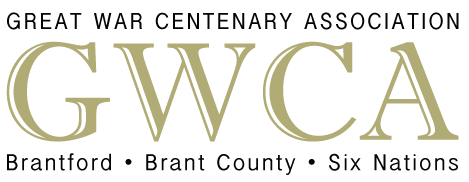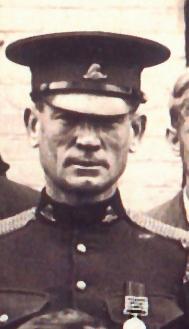BX April 26, 1915
Is Confirmed
That Private William Dawson, late of the 25th Brant Dragoons, but a member of A. Company, 4th Battalion, First Canadian Contingent, had received a flesh wound from a bullet which came from the rifle of a sniper on the Belgian frontier was the news received in the city this morning in a letter to Lieutenant Colonel Harry F. Leonard from Private Herbert Verrell, of A. Company, a chum of Dawson’s.
Private Verrell stated that conditions at the front were such that they could never tell where a bullet was coming from owing to snipers and spies. He says that after being shot Dawson pluckily walked over to the doctor’s quarters, was operated on to extract the bullet, and was doing splendidly. Verrell also states that General Smith-Dorrien complimented the colonel on the physique and the luck of the 4th Battalion, which showed that while on the firing line, they were good intelligent and careful soldiers. General Alderson, commanding the Canadians was reported to have said that the Fourth Battalion was the best in the brigade.
BX May 6, 1915
Getting Better
Lieutenant-colonel H.F. Leonard this morning received a form postcard from Private William Dawson, who was wounded at the front. The card was mailed at the British field post office in France, as shown by the cancelation, but it bore a Canadian two cent stamp with the Toronto postmark, as if someone in Toronto had posted it. The lines on the card with the exception of the following were stricken off. “I am quite well, I am going on well, I was wounded, now better. I have received your letter dated April 3. Letter follows at first opportunity.”
Dawson was wounded by a bullet from a German sniper.
BX January 5, 1916
Pte. W. Dawson Is Badly Wounded – Admitted to Hospital With Wounds in Arm, Hand, Knee and Foot
Mrs. W. Dawson, wife of Pte. William Dawson of the 4th Battalion, now in France, this morning received a telegram from Ottawa officially reporting the admittance of her husband to No. 23 General Hospital, Etaples, on December 24. His injuries consist of gunshot wounds in his arm, hand, knee and foot. How serious the injuries are is not known. Pte. Dawson, previous to his departure from the city, was Sergeant Major with the 25th Brant Dragoons. He was one of the first men from Brantford to go to the front, and was a very well known soldier.
BX June 30, 1916
Two Veterans Welcomed home After Being Returned Invalided – Gunner E. Storor and Pte. William Dawson – Reception Given to Heroes by Local Citizens – Their Experiences – Address Given
Brantford welcomed two more of her soldier sons last evening, when Gunner Edgar Storor and Pte. William Dawson, who have been invalided home, arrived from Toronto on the 8.32 train. Hundreds of citizens had gathered at the station, as well as a body of returned soldiers and several hundred men from the local battalions. After heart touching greetings from relatives, the soldiers who arrived home were taken to the Market Square. A cheering crowd lined Market Street, and the square was packed with people.
Ex Mayor J.H. Spence, J.H. Ham, M.A.A. and Capt. S.E. McKegney of the 215th Battalion spoke briefly, expressing the pleasure all took in welcoming them home. Capt. McKegney made a short recruiting speech. Seeing the soldiers back, he said, would inspire those now in khaki to do their best and those not in the King’s uniform to don it. There were local battalions for them to join.
Tremendous ovations were given both heroes. At the station friends of Pte. Dawson lifted him to their shoulders and triumphantly carried him to a waiting automobile amidst the cheers of the crowd. When Capt. McKegney was speaking at the market and pointing out the fact that men were needed, a voice in the crowd called out “the 125th needs 40 men.”
Both Dawson and Storor spoke briefly, but they being tired out, their voices did not carry far through the crowd. Both looked remarkably well, but were thoroughly tanned. Pte. Dawson, in the course of his remarks referred to a number of Brantfordites, and particularly mentioned the good work Nurse Ruddy and Dr. Wilkes (sergeant in the 25th Dragoons when he left) were doing at the front. To the fact that they were in the hospital when he was taken to be operated on he claims he owes his life.
Brought Back Souvenirs
Two metal souvenirs were brought back by Pte. Dawson in his body. In all 18 pieces of shrapnel entered his body, but 16 pieces have been removed. One of the two left is in his knee, and the other the muscle of his right arm. He was wounded by shrapnel in six places.
Pte. Dawson crossed over with the First Contingent and was first wounded by a German sniper on March 21 of last year. From this wound he recovered and returned to the front to receive the casualties, from which he is now suffering, at Kemmel, Belgium, on December 19. Pte. Dawson is incapacitated by reason of incurable stiffness in the right arm. Otherwise he believes he is none the worse for his war injuries.
Gunner E. Storor
Gunner Edgar Storor, who walked with a cane having had one of his knees injured, is a veteran of the siege of Ladysmith in the South African war. He went to the front with the 32nd Battery. He is 40 years of age and resides at 15 Gordon Street. Gunner Storor has had extensive military experience, being for 13 years in the 3rd Bedford Regiment, and in both the Indian (Chitral) and South African campaigns. He went overseas in December 1914. Gunner Storer is a married man with a family of several children.
BX March 20, 1918
An Operation
Private William Dawson of the Fourth Battalion underwent an operation at the Hamilton Hospital this week for the removal of shrapnel from his arm. He is reported to be doing well.

